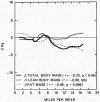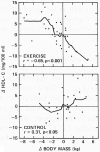Does weight loss cause the exercise-induced increase in plasma high density lipoproteins? - PubMed (original) (raw)
Clinical Trial
Does weight loss cause the exercise-induced increase in plasma high density lipoproteins?
P T Williams et al. Atherosclerosis. 1983 May.
Abstract
Studies showing an increase in plasma concentration of high density lipoprotein cholesterol (HDL-C) with moderate exercise have usually rejected the role of body weight change in the HDL-C raising process, ostensibly because the amount of weight lost has been negligible. To investigate HDL-C changes more thoroughly, we followed initially sedentary middle-aged men randomly assigned to either a moderate running (n = 36) or a sedentary control (n = 28) group for one year. Among runners, one-year changes in plasma HDL-C concentrations correlated strongly with their body weight changes (r = - 0.53, P less than 0.001). Curve-fitting procedures and regression analysis suggested that processes associated with weight change produce much of the plasma HDL-C changes induced by moderate exercise and that changes in HDL-C concentration predominantly reflect changes in the reputedly anti-atherogenic HDL2 sub-component. Further, the interaction between weight change and plasma HDL-C concentration was significantly different (P less than 0.001) in exercisers and controls suggesting that the metabolic consequences of exercise-induced weight change are different from the consequences of weight change in the sedentary state.
Figures
Figure 1
Smoothed scatterplot curves for 1-year changes in lean, fat, and total body mass versus 1-year average reported miles run in exercisers (N = 36).
Figure 2
Smoothed scatterplots and Spearman's correlation coefficient (ρ) for 1-year changes in daily total dietary calorie intake versus Δtotal body mass and reported miles run in exercisers. Horizontal and vertical lines display corresponding mean changes for the control group (n = 28).
Figure 3
Smoothed scatterplots and Spearman's correlation coefficient (ρ) for the assocations among 1-year changes in plasma HDL-C concentrations, total body mass, and reported miles run in exercisers. Horizontal and vertical lines display corresponding mean changes for the controls.
Figure 4
Smoothed scatterplots and Spearman's correlation coefficient (ρ) for baseline to 6-month changes in plasma HDL-C concentrations versus Δtotal body mass. Multiple regression analyses suggest the inverse association between ΔHDL-C and Δtotal body mass in exercisers is significantly different (P < 0.0001) from the slightly positive association between these variables in controls.
Similar articles
- The effects of running mileage and duration on plasma lipoprotein levels.
Williams PT, Wood PD, Haskell WL, Vranizan K. Williams PT, et al. JAMA. 1982 May 21;247(19):2674-9. JAMA. 1982. PMID: 6952022 Clinical Trial. - Increased exercise level and plasma lipoprotein concentrations: a one-year, randomized, controlled study in sedentary, middle-aged men.
Wood PD, Haskell WL, Blair SN, Williams PT, Krauss RM, Lindgren FT, Albers JJ, Ho PH, Farquhar JW. Wood PD, et al. Metabolism. 1983 Jan;32(1):31-9. doi: 10.1016/0026-0495(83)90152-x. Metabolism. 1983. PMID: 6848894 Clinical Trial. - The effects of weight loss by exercise or by dieting on plasma high-density lipoprotein (HDL) levels in men with low, intermediate, and normal-to-high HDL at baseline.
Williams PT, Stefanick ML, Vranizan KM, Wood PD. Williams PT, et al. Metabolism. 1994 Jul;43(7):917-24. doi: 10.1016/0026-0495(94)90277-1. Metabolism. 1994. PMID: 8028519 Free PMC article. Clinical Trial. - High density lipoprotein cholesterol and body composition of female runners.
Rotkis T, Boyden TW, Pamenter RW, Stanforth P, Wilmore J. Rotkis T, et al. Metabolism. 1981 Oct;30(10):994-5. doi: 10.1016/0026-0495(81)90099-8. Metabolism. 1981. PMID: 7278652 - The influence of exercise on the concentrations of triglyceride and cholesterol in human plasma.
Haskell WL. Haskell WL. Exerc Sport Sci Rev. 1984;12:205-44. Exerc Sport Sci Rev. 1984. PMID: 6376133 Review.
Cited by
- Meta-Analyses of the Effects of Habitual Running on Indices of Health in Physically Inactive Adults.
Hespanhol Junior LC, Pillay JD, van Mechelen W, Verhagen E. Hespanhol Junior LC, et al. Sports Med. 2015 Oct;45(10):1455-68. doi: 10.1007/s40279-015-0359-y. Sports Med. 2015. PMID: 26178328 Free PMC article. Review. - Regression from prediabetes to normal glucose regulation is associated with reduction in cardiovascular risk: results from the Diabetes Prevention Program outcomes study.
Perreault L, Temprosa M, Mather KJ, Horton E, Kitabchi A, Larkin M, Montez MG, Thayer D, Orchard TJ, Hamman RF, Goldberg RB; Diabetes Prevention Program Research Group. Perreault L, et al. Diabetes Care. 2014 Sep;37(9):2622-31. doi: 10.2337/dc14-0656. Epub 2014 Jun 26. Diabetes Care. 2014. PMID: 24969574 Free PMC article. - Impact of lowering triglycerides on raising HDL-C in hypertriglyceridemic and non-hypertriglyceridemic subjects.
Miller M, Langenberg P, Havas S. Miller M, et al. Int J Cardiol. 2007 Jul 10;119(2):192-5. doi: 10.1016/j.ijcard.2006.07.132. Epub 2006 Oct 18. Int J Cardiol. 2007. PMID: 17052787 Free PMC article. - The effect of aerobic exercise training on the lipid-lipoprotein profile of children and adolescents.
Tolfrey K, Jones AM, Campbell IG. Tolfrey K, et al. Sports Med. 2000 Feb;29(2):99-112. doi: 10.2165/00007256-200029020-00003. Sports Med. 2000. PMID: 10701713 Review. - Deviations from maximum weight predict high-density lipoprotein cholesterol levels in runners: the National Runners' Health Study.
Williams PT. Williams PT. Int J Obes Relat Metab Disord. 1997 Jan;21(1):6-13. doi: 10.1038/sj.ijo.0800352. Int J Obes Relat Metab Disord. 1997. PMID: 9023594 Free PMC article.
References
- Wood PD, Haskell WL. Effects of exercise on plasma high-density lipoproteins. Lipids. 1979;14:415. - PubMed
- Adner MM, Castelli WP. Elevated high-density lipoprotein levels in marathon runners. J Amer Med Ass. 1980;243:534. - PubMed
- Keins B, Jorgensen I, Lewis S, et al. Increased plasma HDL-cholesterol and apo A-I in sedentary middle-aged men after physical conditioning. Europ J Clin Invest. 1980;10:203. - PubMed
- Huttunen JK, Lansimies E, Voutilainen E. Effects of moderate physical exercise on serum lipoproteins. Circulation. 1979;60:1220. - PubMed
- Kannel WB, Gordon T, Castelli WP. Obesity, lipids and glucose intolerance The Framingham Study. Amer J Ciin Nutr. 1979;32:1238. - PubMed
Publication types
MeSH terms
Substances
LinkOut - more resources
Full Text Sources
Medical



